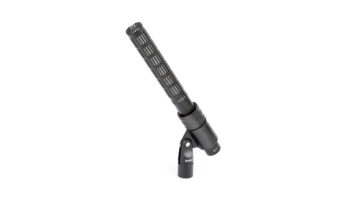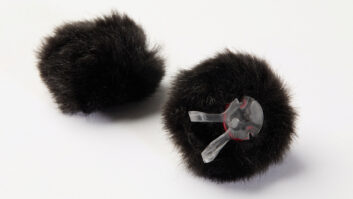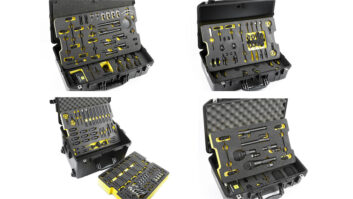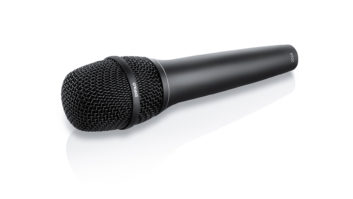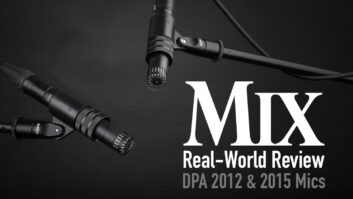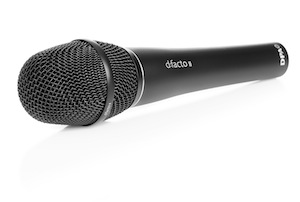
Not quite two years ago, DPA Microphones debuted the d:facto vocal microphone, its first mic designed to deliver studio quality for stage applications. The original d:facto could be used wired or with wireless systems from Italian RF manufacturer Wisycom, but the new d:facto II may also be used with transmitters from Lectrosonics, Sennheiser, Shure and Sony. A unique characteristic of the d:facto II is that the same capsule/head grille may be used on either a wireless transmitter or on a wired handle. When I say “same capsule,” I literally mean that the capsule may be removed from a wireless system and moved to the wired handle—as opposed to purchasing a wireless version of the capsule.
DPA offers various “adapters” to mate the d:facto II to the wireless systems, but the term adapter doesn’t really do justice to the technology inside the device. There’s a very high degree of sonic consistency between the wired and wireless versions of the d:facto II. This is an impressive accomplishment in light of the fact that (a) it’s difficult to predict how the same capsule will behave when incorporated in different RF systems and (b) the capsule requires 48-volt phantom power (±4 volts). Most handheld wireless transmitters are able to provide 5 volts to a condenser capsule, so not only does the DPA adapter step up that voltage to “feed the beast,” so to speak, it also contains circuitry akin to that used in their Compact Series of preamps.
Out of the Box
The d:facto II system sent to Mix consisted of the d:facto II wired microphone and the FAASE2-ewB adapter, which enabled us to couple the capsule and head grille to a Sennheiser ew 300 G3 system (this adapter can be used for Sennheiser evolution, 2000 and 9000 Series handheld transmitters). The d:facto II ships in a semi-hard case with separate compartments for the mic, clip and adapter.
Examining the d:facto II’s sturdy head grille reveals a three-stage filter that protects the capsule from wind noise and pops: the coarse outer grille and, underneath that, two fine mesh screens. The 4018V supercardioid capsule is intentionally situated as far away from the screens as is physically possible, increasing the screens’ effectiveness at filtering wind noise. To reduce handling noise, the capsule mount for both versions sits on a thick rubber cushion, which we found to be very effective. DPA states that the d:facto II can handle SPL up to 160 dB; it certainly did not fold under the pressure of a metalhead screamer, though we didn’t actually measure the SPL of his voice (he was too scary). Frequency response of the d:facto II is spec’d at 100 Hz to 16 kHz ±2 dB, with a 3dB “soft” boost at 12 kHz and a highpass filter down 3 dB at 80 Hz.
Into the Field
We started out with the d:facto II on its wired handle, using it for a variety of singers (mostly male) with a variety of consoles (Avid Venue, Yamaha M7CL and PM5D, Midas Heritage). If there’s one word we’d use to describe the sound of the d:facto II it would be smooth. The mic consistently produced crisp, clear vocals that cut through the mix without ever sounding harsh. From a whisper to a scream, the d:facto II had no trouble capturing all the dynamics we could send its way. In situations where we needed to add compression, the d:facto II did not lose clarity the way lesser mics can, and we found that the mic took EQ very well. On a singer who had what we’d categorize as a smoky voice, a few dB (2.5) of boost at 3.5 kHz popped the vocal through the mix. The three-stage filter was very effective at eliminating wind noise, but overzealous vocalists could create pops if they aren’t careful. Our solution was to add a HPF on the console channel at around 120 Hz, which helped tame the pops.
The d:facto II exhibits mild proximity effect compared to most vocal mics. This is a good thing when working with singers who eat the microphone—the d:facto II did not get muddy in the lower midrange or boomy in the low-frequency range. One thing we found extremely interesting was the d:facto II’s ability to maintain its smooth response when the singer cupped the mic. You may have experienced that “ham radio” sound that results when a singer covers the bottom of the head grille with their hand, but the d:facto barely sounded any different under these circumstances—a refreshing change. The same cupping behavior typically causes a modification in the directional pattern of a cardioid, hyper- or super-cardioid microphone, almost ensuring that the mic will feed back. While we did find that the d:facto II was somewhat more prone to feedback when cupped, the phenomena was not nearly as severe as with other microphones. Apparently DPA’s engineers have worked a bit of magic regarding pattern control.
That magic was also evident in the microphone’s off-axis rejection and off-axis response. For example, when used on a singer/songwriter who was playing acoustic guitar and singing at a coffee-house gig, leakage of the guitar into the d:facto II was so low that we could easily balance the two signals (guitar and voice) without any phase issues, and any leakage that was present in the signal from the d:facto II actually sounded good.
Cross Connections
After we had become familiar with the sound of the wired d:facto II, we tried it with a Sennheiser ew 300 G3 wireless system (see Try This regarding the changeover). Subjectively, the residual noise level of the wireless system was almost exactly the same as the wired version, with maybe a hair more hiss in the wireless version—none of which was evident under performance circumstances (full disclosure: this was not a scientific test. We compared the two through a P.A. in a quiet room, with gain adjusted for a similar output from the wired and wireless d:facto II). Tone quality between the wired and wireless versions was virtually identical, the wireless version being perhaps a hair brighter.
Using condenser microphones on a loud stage is a double-edged sword. The same characteristics we love about condenser mics—extended frequency response, wide dynamic range, sensitivity to soft sounds—can make them a liability. If an engineer is not careful regarding placement, condenser mics can capture a lot of unwanted sound spilling from around the stage. That spill can not only cause instruments such as cymbals to change level via the vocal mic, but also to change timbre due to phase issues between the various microphones. Somehow the d:facto II manages to minimize these issues. It’s sensitive enough to capture the nuances of a vocal without capturing all the background junk, and what leakage was present in the d:facto II sounded pleasing because it wasn’t colored.
Is It Magic?
Creating a studio-quality mic for onstage use is tough, but DPA Microphones has created a useful, versatile product that sounds excellent and meets the challenge. The ability to use the same capsule on wired and wireless bodies is (to our knowledge) previously unheard of, and is an attractive feature of the d:facto II—especially for sound companies that want to offer clients wired and wireless options. Anyone looking to purchase a first-class vocal microphone should have a listen to the d:facto II—wired or wireless.
Steve La Cerra is a NY-based live-sound and recording engineer.
PRODUCT SUMMARY
Company: DPA Microphones
Product: d:facto II
Website:dpamicrophones.com
Price: $899; FAASE2-ewB Wireless Adapter for Sennheiser evolution/2000/9000: $249
Pros: Excellent sound quality, superior off-axis rejection. Versatile system may be used wired or wireless.
Cons: More expensive than your average vocal mic.
Try This
The DPA d:facto II has been designed so that the owner can purchase the 4018V capsule and use it on their choice of wireless system or as a handheld unit. DPA manufactures adapters that allow the capsule/head grille combination to be mounted on a variety of handheld transmitters. Simply remove the head grille from the wired handle and unscrew the 4018V capsule. Thread the adapter onto the wireless transmitter, and screw the capsule onto the adapter. Then replace the head grille over the capsule and you’re ready to go. The entire process takes about two minutes.
